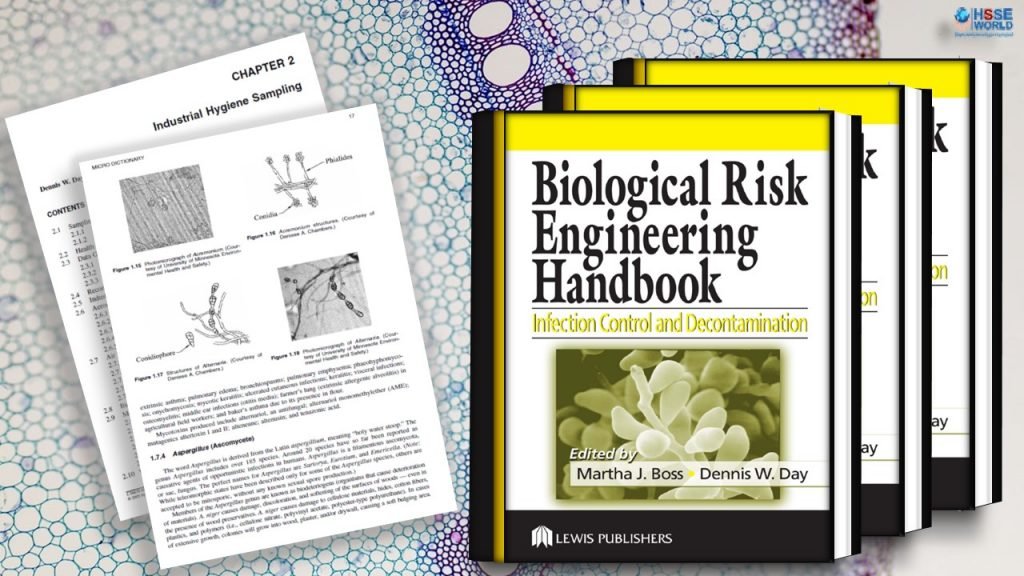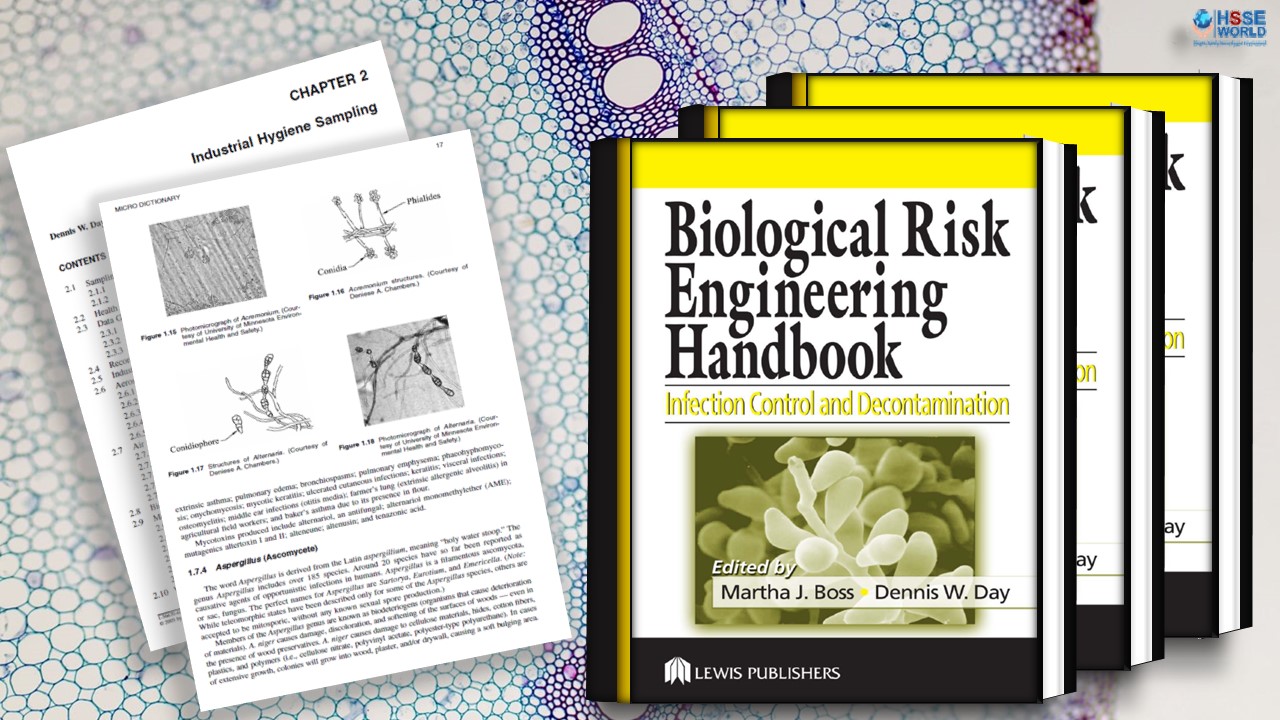Biological risk engineering handbook: control and decontamination /edited by
Martha J. Boss, Dennis W. Day. Biological Risk Engineering Infection Control and Decontamination provides a compendium of biological risk management information. Biological risk is of concern to us all. The biological risks we face vary and include biological contamination within our environment and, more personally, the biological risk to ourselves through disease or the potential for disease. This book deals with a subset of biological risk agents defined as bacteria, molds, yeasts, viruses, and prions. The term biologicals refer to these agents. Of these, the viruses and prions are not currently defined as independent life forms, and the extent to which these agents exhibit the characteristics of organic life are still being debated. The intent of this compendium of information is to foster risk management decisions. In times of strength, we can manage many risks for ourselves and for those around us. As homeland security and other risk-management agendas are addressed politically, increasing emphasis will be placed on codifying biohazard management protocols. The biological risk regulatory process is expected to progress in a manner similar to the chemical risk regulations developed under Superfund. In fact, Superfund was always intended to include uncontrolled infectious substances. The authors of biological risk management regulations face a daunting challenge in that biohazardous agents,
unlike chemicals, can reproduce.
As with most complex subjects, not all the authors included here or in the future will agree on everything. These differences were put aside to provide interdisciplinary discussions that hopefully will lead to sensible risk-management decisions. This text’s authors are bacteriologists, biologists,
industrial hygienists, environmental scientists, microbiologists, engineers, nurses, sanitarians, toxicologists, and safety professionals. All authors used their personal time and offered their professional opinions to shape the research and writing that resulted in this book. Whether they are in the public or private sector, one goal remained preeminent — to provide information to enhance the effectiveness of biological risk management and control.

Elizabeth Buckrucker, a reviewer, is a Project Manager for the Kansas City District Army Corps of Engineers, working in the Environmental Program branch. Elizabeth began her career in the U.S. Army and currently works as a civilian on environmental projects, including the U.S. Food and Drug Administration (FDA) Laboratory Decommissioning Program. In that capacity, Elizabeth met Dennis and Martha. Along with Donald Demers, current Chief of the FDA Safety Staff, and Renee Dufault, who is a Lieutenant Commander in the Public Health Service, formulated the basic concepts for this book during their hours away from duty.
Biological Risk Engineering Infection Control and Decontamination begins in Chapter 1 with a basic microbiological dictionary with emphasis on fungi and bacteria. Viruses and prions are also discussed. Illustrations of basic morphology and the appearance of mold cultures are provided. Chapters 2 and 3 provide sampling and laboratory procedural descriptions. For biological contaminant sampling (molds, bacteria, viruses), coordination between the sampling teams and the ultimate receiving laboratory is essential.

We then shift gears in Chapters 4 and 5 to interpretation issues associated with toxicological studies and ultimately risk assessment. Risk assessment quantitation had been more thoroughly developed for chemical risk, and the authors hope this volume will provide further impetus for synergistic studies related to risk assessment and management of biohazardous agents.
Because one of the exposure routes is inhalation, Chapter 6 deals with ventilation design. Should a disruption occur in ventilation equipment or other building structures, maintenance will be required.
Good design principles will ensure that maintenance can be safely and easily accomplished. Thus, it is emphasized in both Chapters 6 and 7 that correct design and ongoing maintenance using interdisciplinary expertise are essential.
Contents
The Contents of the Biological Risk Engineering Handbook
- CHAPTER 1 Micro Dictionary
- Dennis W. Day, Martha J. Boss, Jerry King, and Melanie Karst
- CHAPTER 2 Industrial Hygiene Sampling
- Dennis W. Day, Martha J. Boss, R. Vincent Miller, and Chris Wrenn
- CHAPTER 3 Biological Sampling and Lab Interpretation
- R. Vincent Miller and Martha J. Boss
- CHAPTER 4 Toxicology
- Richard C. Pleus, Harriet M. Ammann, R. Vincent Miller, and Heriberto Robles
- CHAPTER 5 Risk Assessment
- Harriet M. Ammann, R. Vincent Miller, Heriberto Robles, and Richard C. Pleus
- CHAPTER 6 Ventilation Systems
- Martha J. Boss and Dennis W. Day
- CHAPTER 7 Maintenance
- Martha J. Boss, Dennis W. Day, and Marwan Bader
- CHAPTER 8 General Infection Control
- Renee Dufault, Martha J. Boss, and Edward Rau
- CHAPTER 9 Medical Setting Infection Control
- Renee Dufault, Rita Smith, and Martha J. Boss
- CHAPTER 10 Decontamination and Assessment
- Brian Wight and Martha J. Boss
- CHAPTER 11 Legionella and Cooling Towers
- Martha J. Boss and Dennis W. Day
- CHAPTER 12 Biocides
- Martha J. Boss and Dennis W. Day
- CHAPTER 13 Laws and Regulations
- James D. Hollingshead and Martha J. Boss
- CHAPTER 14
- Proposed OSHA Tuberculosis Standard and CDC Guidance Comparison Martha J. Boss and Dennis W. Day
- CHAPTER 15 Security
- Martha J. Boss and Dennis W. Day
- Index
Download the book
More Downloads
- E-Books: Healthcare Hazard Control & Safety Management
- E-Books: Safety, Health and Working Conditions Training Manual
- E-Books: Energy Efficiency in Water and Wastewater Facilities
- E-Books: Fire Service Features of Buildings and Fire Protection Systems
- E-Books: Evaluation of Fire Safety free download
- E-Books: PPE for Chemical, Biological, and Radiological Hazards free
- E-Books: Changing the Workplace Safety Culture free download
- E-Books: Site Emergency Planning Workbook
- E-Books: Load Restraint Guide
- E-Books: Essential Practices for Creating, Strengthening, and Sustaining Process Safety Culture
- E-Books: System Safety Engineering and Risk Assessment
- E-Books: Permit-Required Confined Spaces
- E-Books: Is it Safe to Enter Confined Space?
- E-Books: 5-Minute Workplace Safety Talks
- E-Books: Safety Culture and High-Risk Environments
- E-Books: Practical Guide to Industrial Safety
- E-Books: Slip, Trip, and Fall Prevention for Healthcare Workers
- E-Books: Health and Safety at Work Key Terms
- E-Books: Fundamentals of Process Safety Engineering
- E-Books: Gas Detection Hand Book
- E-Books: Occupational health and safety management systems ANSI-AIHA-z10-2012
- E-Books: Hot Work on Drums and Tanks
- E-Books: Human Fatigue Risk Management
- E-Books: Guidelines for the provision of facilities and general safety in the construction industry
- E-Books: Handbook of Training in Mine Rescue and Recovery Operations ( 2021)
- E-Books: Code of Practice for the Safe Use of Lifting Equipment – Edition 9 (Nov 2019)
- E-Books: Free Forklift Health and Safety Best Practices Guideline
- E-Books: Handbook of Hazardous Chemical Properties
- E-Books: Human Performance Improvement through Human Error Prevention
- E-Books: Principles Of Fire Risk Assessment In Buildings
- E-Books: Investigation of Occupational Accidents and Diseases
- E-Books: Radiation Protection and Safety in Industrial Radiography
- E-Books: Basic Guide to System Safety, Third Edition
- E-Books: Food Safety Management-A Practical Guide for the Food Industry
- E-Books: Safety identification: Escape and evacuation plan signs- ISO 23601
- E-Books: Safety at Work
- E-Books: The Safety-Critical Systems Handbook 4th edition
- E-Books: Fundamental principles of occupational health and safety
- E-Books: Fire Safety Risk assessment Guide – Sleeping Accommodation
- E-Books: Mental health at work series
- E-Books: Live Fire Training: Principles and Practice
- E-Books: Pre-Startup Safety Review Guide
- E-Books: Fire and Emergency Drill Manual and Building Inspection Guide
- E-Books: Health and Safety: Risk Management 5th edition
- E-Books: Fire Protection systems -Third edition 2021
- E-Books: Fire Safety Logbook templates
- E-Books: From Accidents to Zero
- E-Books: Electric Safety Practice and Standards
- Your steps to chemical safety
- E-Books: Ergonomics and Psychology Developments in Theory and Practice
- E-Books: HAZOPS Should BE fun-The Stream-Based HAZOP
- E-Books: Safety Health and Environmental Auditing
- E-Books: A Quick Guide to Health and Safety
- E-Books: Occupational Ergonomics A Practical Approach
- E-Books: Job Hazard Analysis A Guide for Voluntary Compliance and Beyond
- E-Books: Electrical Safety of Low Voltage Systems




